Budapest to Amsterdam 2022
Rhine River
The Rhine is one of the major European rivers. The river begins in the Swiss Alps and flows in a mostly northerly direction through the German Rhineland. Finally in Germany the Rhine turns West and flows into the Netherlands where it empties into the North Sea.
October 10


Rüdesheim, Germany
Rüdesheim is officially Rüdesheim am Rhein, and is and is known for wine-making, especially of Riesling wines. We docked in the town just before 9am, and we are taken from the pier by a Tourist Train to the music box museum .

Siegfrieds Mechanisches Musikkabinett is a museum for mechanical musical instruments. The museum provides information about the history of self-playing music and its instruments. It has a showcase of approximately 350 self-playing, mechanical music instruments spanning 3 centuries.






































Such a fascinating look at a musical history, when we start seeing wandering musical machines in Holland towns they mean so much more. I have too many videos showing these instruments at work.








Oh no, another Käthe Wohlfart store
From the main street of town we could take the gondola ride to the top of the local mountain for great views over the city. There was an option to do the Emerald Active hike with Harry, but when there's a nice gondola ride over the wine fields... why hike?














The Niederwald monument (Niederwalddenkmal) is a monument built between 1871 and 1883 to commemorate the founding of the German Empire in 1871 after the end of the Franco-Prussian War.







After a nice cold beer and a snack overlooking the town, we headed back down via the gondola.







Everywhere there's signs...










St. Jakobus is a Catholic church and a former parish. It dates back to the 10th century, was expanded around 1400, and again in 1913/14. The church was severely damaged by bombing in World War II, and rebuilt from 1947 to 1956.





















We re-board just in time as the boat pulls out of Rüdesheim.





After lunch back on the boat, we are starting one of the most scenic areas of the river, the Rhine Gorge... Castle row. The Upper Middle Rhine Valley has been part of the UNESCO World Heritage since 2002. Everyone that doesn't have a fear of drafts heads to the upper deck, and Igor provides a Play-by-Play of the castles and their history as we pass.
In the Middle Ages, the Rhine was one of the most important trade routes between north and south. The princes and nobles of the Middle Rhine region built the castles not only as defensive and residential castles, but also as customs stations to collect money and customs duties from the numerous traders and boatmen on the Rhine. And plenty of it!





Ehrenfels Castle built in 1212
The story of how Mäuseturm came to be called the "Mouse Tower" comes from a folk tale. During a famine in 978, the cruel ruler Hatto II had all kinds of grain stored away, and when the peasants revolted, he tricked them to go to a barn where they could get food. He locked them in and lit the barn on fire. Joking "Hear the mice squeak". When he returned to his castle he was attacked by a swarm of mice, that chased him across the river to his Toll Tower, where they chewed through the doors and ate him alive.
In 1298 the structure became an official customs collection tower.
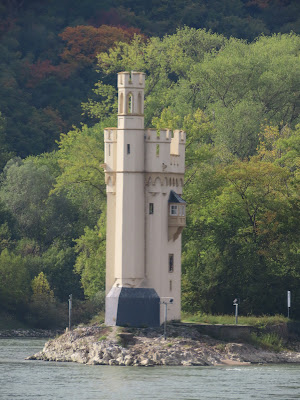

Mäuseturm (Mouse Tower) dating back to 968



Town of Assmannshäuser



Rheinstein Castle constructed in about 1316/1317




Reichenstein Castle also known as Falkenburg, dating between 1100 - 1200



Sooneck Castle first mentioned in 1271




Town of Niederheimbach


Fürstenberg Castle first mentioned in 1295

Burg Nollig was originally constructed around 1300 as a half-timbered fortified tower.

St Martin in the town of Lorch



Sankt Bonifatius with Clemenskapelle in the background


Burg Stahleck, a 12th-century fortified castle with a partial moat




Town of Bacharach and Ruine Wernerkapelle from 1287


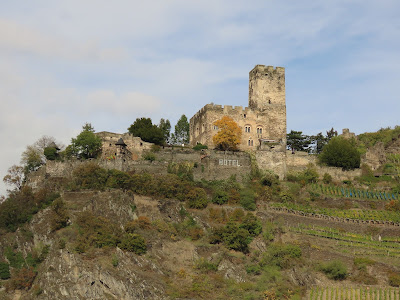

Gutenfels Castle was built in 1220. It was used with the toll castle, Pfalzgrafenstein Castle in the middle of the Rhein and the fortified town of Kaub on the farthest side to provide an impenetrable anti-toll zone for the Holy Roman Emperor until Prussia purchased the area (1866) and ended this toll in 1867.





Pfalzgrafenstein Castle built in 1326-1327, was also known as Pfalz Island
The next castle was special... Schönburg Castle in Oberwesel was where Norine and I stayed way back in 2003. To see it on the hillside as we cruised past brought back all kinds of fond memories. Memories of hauling our luggage up that hill until a complete stranger picked us up and gave us a ride.





Schönburg Castle







Town of Oberwesel



Even their train tunnels are impressive
The next famous landmark we passed was the infamous Lorelei Rock. A poem tells the story of the beautiful Lore Lay, betrayed by her sweetheart, is accused of bewitching men and causing their death. Rather than sentence her to death, the bishop consigns her to a nunnery. On the way there, accompanied by three knights, she comes to the Lorelei rock. She asks permission to climb it and view the Rhine once again. She does so, and, thinking that she sees her love in the Rhine, falls to her death.
A follow up poem continues the legend describing the Lorelei female as a sort of siren who, sitting on the cliff above the Rhine and combing her golden hair, unwittingly distracted shipmen with her beauty and song, causing them to crash on the rocks.


The Loreley statue sits on a causeway on the Rhine, below the famous Lorelei rock. These damn tourists, knowing our ship was passing, just had to stand right in the line of sight. Asshats.







Burg Katz (Cat Castle) first built around 1371




Burg Maus (Mouse Castle) construction was started in 1356


Rheinfels Castle started in 1245 was the largest fortress in the Middle Rhein Valley


Town of St Goar
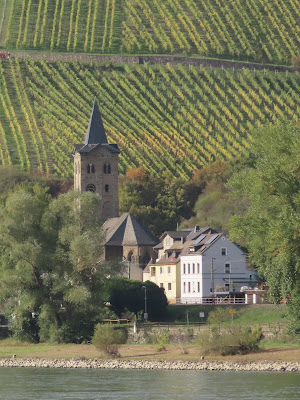




Town of Hirzenach
The 13th century castles of Liebenstein and Sterrenberg lie high above the medieval pilgrimage site of Kamp-Bornhofen. Together they are also known as the "hostile brothers". Numerous legends deal with the feuding descendants of a king, who built the two unique castles in the course of their inheritance dispute - closer than any other two castles on the Rhine have ever been built. A very special feature is the so-called "defending wall" between the castles of Liebenstein and Sterrenberg.
The legend has it that the two brothers fell in love with the same woman, Angela, who despite being drawn to the elder brother, made a promise to stay true to the younger as he went to do battle in a distant land. When he returned triumphant from war, he had on his arm a Greek bride. Driven to despair, Angela died celibate in a convent. The two brothers became bitter enemies.
An agreement was made to go hunting together, and the first to wake up, was to send an arrow to wake up the other, just as the arrow was launched the other brother opened the shutters and was killed by his own brother. To this day the ghost of Angela is said to haunt Castle Liebenstein where she was to have lived with her beloved. “On a full moon,” says Klaus Nickenig, manager of the castle, “she can be seen wandering around here, with her long blonde hair and white clothes.”



Sterrenburg Castle  Burg
Liebenstein
Burg
Liebenstein


Wallfahrtskloster Bornhofen

Kastell Bodobrica ruins


Kamp-Bornhofen Pilgrimage Church
Boppards Alte Burg (Old Castle) dates to the 2nd half of the 14th century, it had many purposes. It was a fortification to keep enemies out, a stronghold to keep the Boppard nobles at bay and a toll castle for collecting toll from the ships passing Boppard and filling the Elector’s pockets.. St. Severus, Basilika Minor, with its two towers was built in the 12th /13th centuries over the Roman baths.


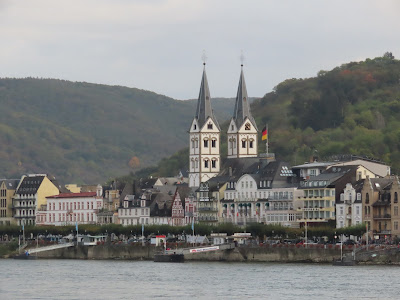




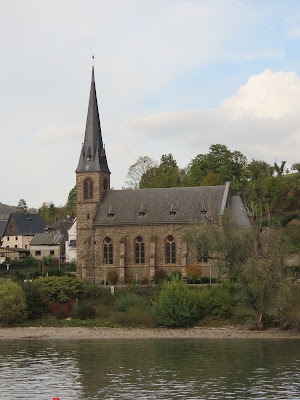

One of these things is not like the other


Liebeneck Castle probably built in the 12th century


Drei Schornsteine (three chimneys)


Our favourite server, Valerya and Marksburg Castle
When we took Valerya's picture, she asked if we could send them to her, so she could send the pictures back home to her mom. I was happy to oblige, and she was happy with the castle photo-bomb.






Marksburg Castle




Schloss Martinsburg


Lahneck Castle built in 1226








Stolzenfels Castle finished in 1259, converted into a palace in 1842


Johanniskirche in Lahnstein


Maximilians-Brauwiesen (yep, it's a brewery)
After a great afternoon out in the sunshine, watching castles float by, we are heading into the town of Koblenz, and passing one last castle... Ehrenbreitstein Fortress, situated across the river from Koblenz, and connected via a gondola.
Occupying the position of an earlier fortress destroyed by the French in 1801, it was built as the backbone of the regional fortification system by Prussia between 1817 and 1828. Ehrenbreitstein Fortress guarded the middle Rhine region, an area that had been invaded by French troops repeatedly before. The Prussian fortress was never attacked.



Koblenz, Germany


Koblenz was established as a Roman military post around 8 B.C. Its name originates from the Latin word c?nfluent?s, meaning "at the confluence". The confluence of the Rhine and Moselle rivers. Koblenz celebrated its 2000th anniversary in 1992.
After a day of sunshine, Norine, Afie and I walked into town, and it started raining.





The Basilica of St. Castor was built between 817 and 836. On November 6, 1944 St. Castor’s was damaged by a British air raid. In March 1945 the outer walls were also damaged by artillery. The stone material including the vault, however, remained largely intact. In 1948 enough money was raised for its reconstruction and a 25-year renovation began.



A fountain called Kastorbrunnen ("Castor well") was built in front of the basilica during Napoleon’s invasion of Russia in 1812.


The Jesuit Church of St. John the Baptist is also called the City Church, a very simple but functional community church. It stands on the site of the 17th-century church on Jesuitenplatz, which was destroyed in 1944.








We happened upon a large relief called "The good old days" that was created around 1912 for the newly built Hotel Rheingold. The relief shows an atmospheric tavern scene with citizens in a social get-together, in keeping with the tradition of the Gründerzeit at the end of the 19th century. During the heaviest air raid on November 6, 1944, the Hotel Rheingold was destroyed down to its foundations, like all the other houses on Rheinstraße. Only the front door with the relief above survived the bombing almost unscathed.


We headed in to Adaccio restaurant for dinner, mostly to escape the rain.By the time we were finished, the rain had mostly stopped.



We checked out a couple shops and then headed back to the ship.


When we got back to the room I discovered an Invitation to dine with the captain, either it was based on alphabetical by home city, or somebody noticed that I had shared my smoky beer with other passengers.

Tonight's entertainment was an Accordion player, and I know what everyone is thinking, but he was actually pretty good, and entertaining. He played a wide variety of traditional Bavarian German songs..



We might have stayed up late that night drinking, but I really don't remember. Some kind of Salted Caramel White Russian may have been involved, it was recommended by our server Valeyria, she's a troublemaker.
October 11
Cologne (Köln), Germany
It was an early foggy morning on our last day in Germany. We boarded a bus and were taken to a central area in Cologne.




We did a morning walking excursion to Köln with a pretty terrible guide from Italy, big historic churches around him and he's going on about being at the beach, and some stupid Hardy and Laurel statue while we are all standing there freezing.
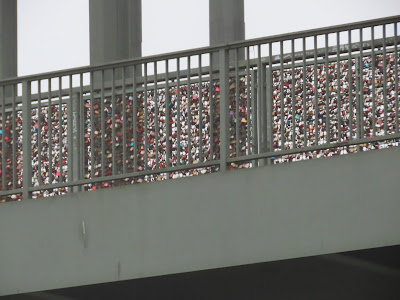

Barely a mention of the love-locks or this unique fountain.






All this history around us, and we get 30 minutes of this 'Hardy & Laurel' statues (as he described them). Insteadhe prolongss the tour with"Anybody want their pictures, or to touch the shiny bronze area, it will give you... blah, blah, blah"















We get 2 seconds of description of a bronze statue mooning the rathaus over non-payment for city statues, but not a mention of the other 2 odd statues. Somebody did not like Konrad.




Things are looking pretty foggy over at the Dom, but we haven't gotten there yet.



The Heinzelmännchenbrunnen water well is quite interesting. It depicts the legend of the Cologne Brownies. The little house gnomes are said to have done all the work of the citizens of Cologne during the night, so that the inhabitants of Cologne could be very lazy during the day. According to the legend, this went on until a tailor's wife got so curious to see the gnomes that she scattered peas onto the floor of the workshop to make the gnomes slip and fall. The gnomes, being infuriated, disappeared and never returned. From that time on, the citizens of Cologne had to do all their work by themselves.






As Luigi, or whatever his name was, goes into another drawn out story about something of non-importance, the 3 of us just turned off our quiet box devices and walked away... we knew where to meet the bus back to our boat later.
We walked over to the dominant Dom Cathedral, one of the few structures that actually survived the bombing of Cologne during WW2. It is so big, that it's near impossible to get a picture without using a wide angle lens or doing a Panorama shot.


















The stained glass windows are just stunning as the sun breaks through the fog.

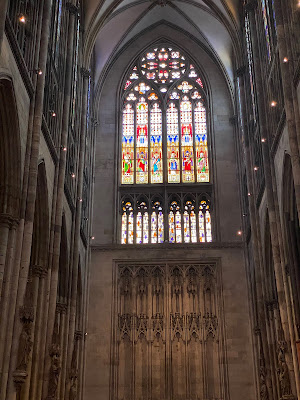















After exploring the inside of the cathedral (we didn't bother climbing up as it was too foggy), we left the Dom and went looking for some facilities, something that was not covered on the earlier tour.



We finally found a bathroom, in one of the old standby's... McDonalds, maybe the most
historic McDonalds ever.
Of course Norine had to wait 30 minutes to finally get in, most popular bathroom in
Cologne.


Feeling refreshed, we wandered the main shopping street, found a Christmas ornament and some basics for the rest of our trip.

















We made our way back to the bus and we're back on the ship in time for lunch. Now we have a great view of the Dom.


Our current ship  Our next ship
Our next ship
As we are heading away from Cologne, I spot this blue and white icebreaker ship, it's the Hondius, the same ship we will be taking on our Antarctica expedition in 2023. How funny that I would spot that exact ship, that will be in Argentina months later, right here in Germany. It looks nice, but nothing like the luxury of our Emerald Destiny ship.
We have an early afternoon port talk, all about end of cruise planning as we only have a few days left, Amsterdam is our next port of call. The remainder of the day was cruising past factories and nuclear power plants.





Finally, the time had arrived, nervously we head to our table for the dinner with the captain.We arrived at the specified time, and we are the first to arrive, is that good.Happily we discover that sitting across from us is our fellow Coquitlam passengers. A good opportunity to get to know this lovely couple that live mere blocks away from us.As it turns out, the captain wouldn't be joining us, and we have our dinner with Igor, the cruise director, Harry, the entertainment and activities director, as well as 4 other passengers from the ship.

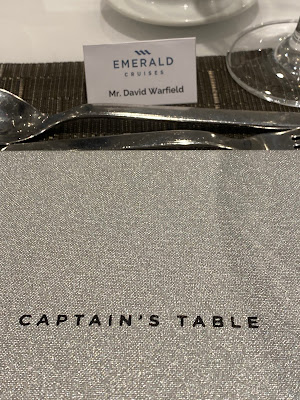
It was a very nice dinner, with excellent service, food and a fun evening talking with the group.The night was made special when the entire staff came out to sing "Leaving on a jet plane" to us and wish us farewell.

Harry has to excuse himself during dessert as he has to arrange the evenings entertainment, it was Disco Night in the lounge. After dinner we headed up to the lounge, and Harry shows up in full disco garb, right down to shaving his beard and sporting a great porn moustache. We all may have danced a lot that night.


Completely exhausted, we returned to our room and discover this masterpiece.

We need a good nights sleep, because tomorrow we arrive in Amsterdam.


